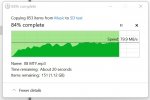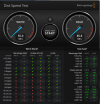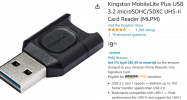I did some side-by-side comparisons.
TL;DR: the Card Reader copy was faster than the USB copy by many factors. I probably could double my USB copy speed by getting a better cable, but it would still be far slower.
<S
tart of subjective, which can be skipped>This is a purely subjective note on preference of method: when I went to hook up the drone for the USB copy, I was reminded of everything required, getting out the aircraft, pulling out the legs (to get to the ports), finding a place for it on the desk, powering it up (hopefully one always has a sufficiently charged battery, otherwise you have to power it down then get another battery), opening the USB door (yes, both the USB port and SD card slot have doors), then you can connect and copy.
To me, getting the card out without otherwise messing with the aircraft, and dealing with a small card reader on the desktop is a lot less bother. <
End of subjective>.
SD CARD: exact same card used in all copies with identical 82 files of ~30GB video
USB hardware:
- Anker USB-C to USB-A Cable:
- plugged into computer front panel USB port (connected to motherboard with no USB hubs between)
CARD READER hardware:
- Sony MRW-S1 SD card reader:
- plugged into same front-panel USB port as USB (mentioned above)
METHOD OF COPY:
- Robocopy utility, comes with Windows (command-line batch file tool)
- Example command line use:
- robocopy "%SourceFolder%" "%TargetFolder%" /MT:24 /E /NP /TEE /LOG:log.txt
- where
- %SourceFolder% = drive-letter \ path of video files on source (drone or card reader)
- %TargetFolder% = drive-letter \ path of destination (same destination drive for both copies)
RESULTS (copied from summary at bottom of each robocopy log):
Times : 6:07:15 0:15:06
Speed : 36,731,183 Bytes/sec.
Speed : 2,101.775 MegaBytes/min.
Times : 0:45:29 0:02:10
Speed : 255,081,725 Bytes/sec.
Speed : 14,595.894 MegaBytes/min.
The card reader was ~8 times faster for totals (first number), ~7 times faster for per file averages (second number).
That's 255 MB/s vs 36 MB/s. If I got a better USB cable to double the speed (reportedly being around 70 MB/s. though I'm not sure of the method used to derive that number), the card reader copies would still be about 3-4 times faster.
[
Earlier in this thread, I reported 80 MB/s when I did a simple Windows copy and screen-capped the progress dialog while it was still copying, which is not a very test worth method. I don't know why that reported slower, but it was a completely different method from ROBOCOPY at the command-line, and of course I used the same ROBOCOPY method for both USB vs Card reader compares above. ]
I RAN EACH ROBOCOPY TEST 3 TIMES TO CONFIRM SPEEDS. If you're comfortable around batch files, this is an easy test to do yourself (requires all hardware mentioned above, of course). You can use another copy method as long as you get a good average at the end and use the same copy method for both tests.
ONE MORE REASON NOT TO USE THE USB PORT FOR FILE TRANSFER: if the USB-C port on the aircraft is the only method of connecting the aircraft to the computer for use of analytic, configuration, and calibration tools (such as DJI ASSISTANT), then I wouldn't want to wear it out by using that port for file transfer.
This is the same reasoning I use with the RC side USB port, which I only use for charging. I use the RC's bottom USB port for flying, because many people have broken the side port using it for flying due to it's fragile connection to the RCs internal PCB.
Chris
















